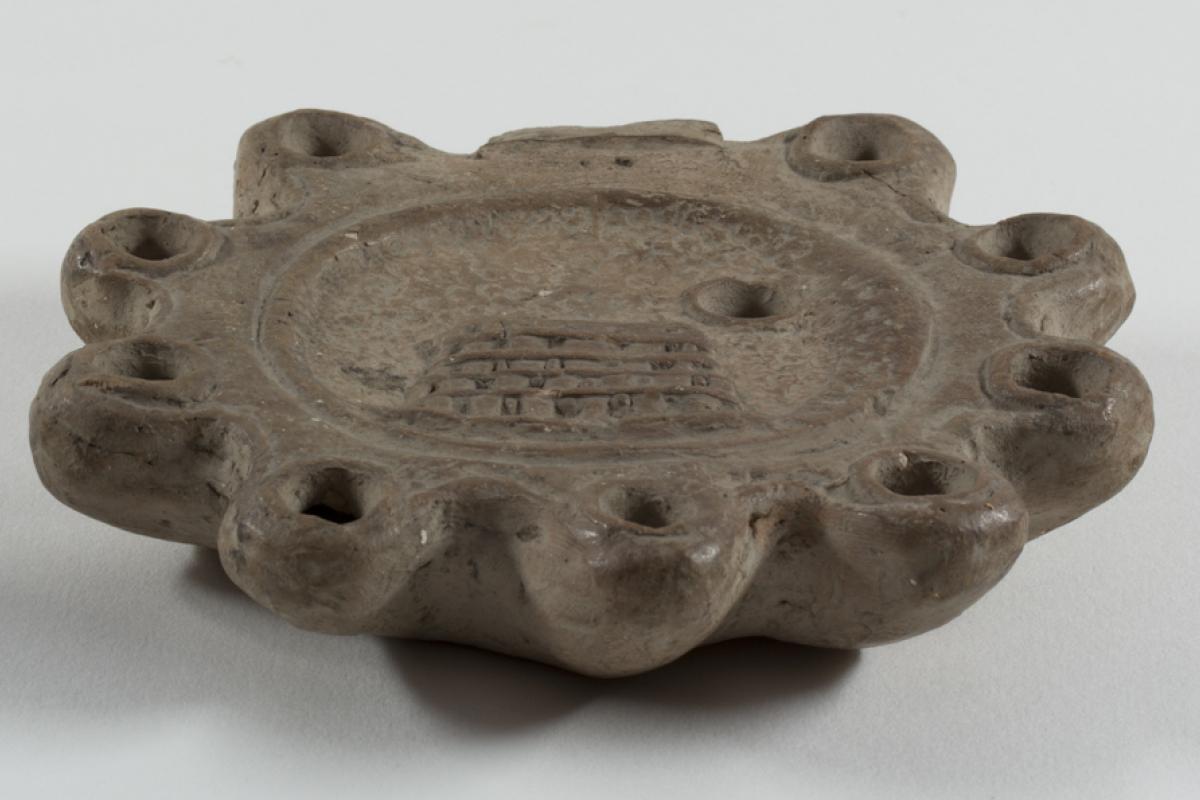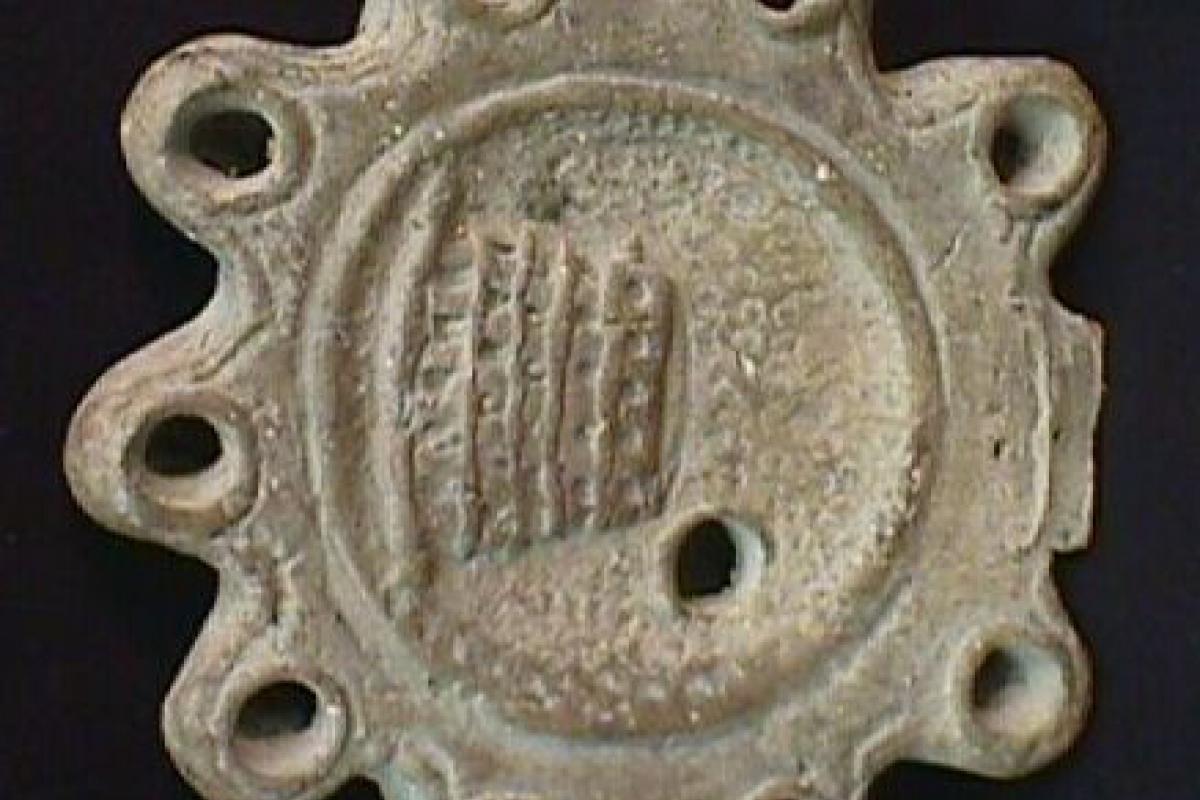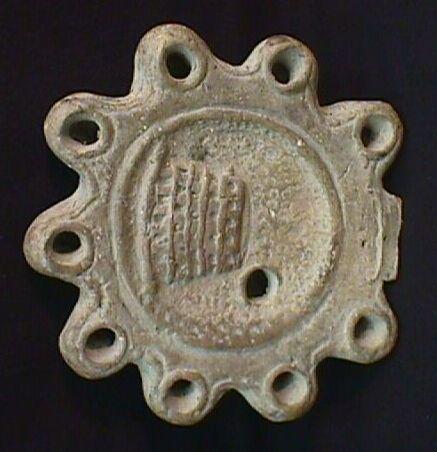Multi-Nozzle Lamp
Multi-Nozzle Lamp
Imperial Roman, 300/499 CE
terracotta
height 2.9 cm
diameter 15.2 cm
Portland Art Museum, The Sally Lewis Collection, 26.44
Chloe Massarello, Medieval Portland Capstone Student, 2008
The Portland Art Museum houses a unique lamp of mysterious origins. A part of the Lewis Collection, it is displayed amongst other examples of Roman items, and next to other Roman lamps. This particular lamp stands out in sharp contrast to the others that share its display case, however, and its non-conformity only seems to deepen when it is compared with the images of multitudes of other Roman lamps found in archaeological catalogs. It shares only surface-level similarities with a select few examples of the Roman lamps to be found in these books. Dated to the late Roman period and of unknown geographic origin, questions have been raised regarding its antiquity.
First among the many features that make the lamp unusual is that it is a multi-nozzle lamp. Examples of other multi-nozzle lamps are out there, but they are relatively few and far between in the crowd of single-nozzle variations, and originate from many places, including Egypt, Palestine, Syria, Greece, and Italy. Many of the multi-nozzle lamps only have two nozzles. The museum's lamp boasts nine separate nozzles that radiate out from the central body of the lamp. The overall shape of the lamp is circular, and the nozzles cover the whole outside circumference, except for a small space where a handle, which has broken off, used to be attached. While there is no way to know for certain what the handle would have looked like or how large it would have been, the remnants suggest that it would have been a projecting tab. Tabular handles appear in a wide variety of shapes, from leafs and triangles to crescents. Many lamps have a simple finger ring handle, but this does not seem to have been the case with the museum's lamp.
Perhaps the most striking difference between the lamp and most others is that the lamp was made by hand. Lamps crafted by hand were relatively rare. Most lamps were either made on a wheel or with a mold. (1) asymmetry of the lamp and its general quirkiness are all indicators that it was made by hand. Each of the nozzles is different from the others. They vary in size and shape, and even the nozzle openings are imperfect. The spacing between nozzles and the distance they project from the body differs markedly. All of the nozzle openings are encircled by a groove that continues along the border of the entire lamp. In the center of the lamp, called the discus, (2) is a lopsided circle inside which is a decorative image that is difficult to identify.
At the bottom of the image, a line cuts across a section of the circle. Above this line is a strange grid pattern. Five tiers are clearly visible. They start wide at the bottom and taper slightly towards the top, which has a curved line arcing from one side of the grid to the other. The image has not been identified. Two possibilities include a fort or other architectural structure, and a ship. (3) If the image is that of a ship, the line at the base could represent the body of the ship, while the grid pattern above it could be the sail. Roman mosaics provide examples of images of ships that have grid patterns on the sails. (4) While the bodies of the ships are depicted in much greater detail in the mosaics, the lamp's is a simple rendering in keeping with the rest of the decoration on it. At the upper right corner of the grid pattern is the lamp's filling hole. The rest of the interior of the circle is filled with stippling.
With a height of 1.25 inches and a diameter of 6.25 inches, the lamp is relatively large. With so many nozzles this is to be expected because more nozzles meant that more oil was required to keep the flames going. Different types of oil could be used, including fish oil and nut oil, but the most common was olive oil. (5) Lamps like the museum's were made with an enclosed fuel chamber so as to prevent contaminants from getting into the oil, to keep it from spilling, and to keep animals from drinking it. (6) Each of the nozzles would have had a wick made of various materials ranging from linen to papyrus, capable of producing light comparable to that provided by a candle. (7) The lamp then would have been able to provide light equivalent to nine candles if every nozzle was in use.
Lamps were used by everyone in Roman society, and the method of production and material the lamp is made of indicates who would have used it. For instance, less affluent individuals would have had simpler lamps produced using a wheel or mold, while a wealthy individual would have owned an ornate lamp fashioned from metal. (8) Thus this multi-nozzle lamp seems to be a bit of a contradiction. It is made of terracotta and is poorly crafted, but also has a large capacity, and oil was a valuable resource. Since the oil used for fuel was edible, as Donald Bailey points out, only regions which managed to exceed their necessary food output were able to use oil for much other than food preparation. (9) It seems reasonable, then, that whoever the multi-nozzle lamp belonged to was not affluent, but rather lived in an area that was able to produce a surplus of food and oil sufficient enough to keep the price of oil down.
|The lamp is so unique and bizarre that the possibility of it not being the genuine article has to be considered. Amidst the Portland Art Museum's information on the lamp is the observation that there are no signs that it was ever used, which may indicate that it is in fact a modern item and not Roman at all. It is tentatively dated to the late Roman period of around 300-499 CE, but its singularity defies comparison with other lamps that could help provide a more accurate date, or an accurate identification for that matter. An example of a multi-nozzle lamp that it shares some features with is number 6220 in the Schloessinger Collection at the Hebrew University of Jerusalem. This lamp has ten nozzles and is simply decorated. It also appears, due to its asymmetry and rough appearance, to have been hand-made. It is tentatively dated to about the same period. (10) The similarities, however, do not extend beyond the basic. It appears as if the Portland Art Museum is destined to remain the home of a bit of a mystery.
Notes:
1. Donald M. Bailey, Greek and Roman Pottery Lamps (Portsmouth: The Trustees of the British Museum, 1963), 13.
2. Ibid., 22.
3. Karen Carr, e-mailed message to author, July 01, 2008.
5. Bailey, Greek and Roman Pottery Lamps, 10.
6. Ibid., 9.
7. Ibid., 10.
8. Ibid., 11.
9. Ibid, 11.
10. Renate Rosenthal and Renee Sivan, Ancient Lamps in the Schloessinger Collection, vol 8 of Oedem: Monographs of the Institute of Archaeology the Hebrew University of Jerusalem, edited by Y. Yadin, Jerusalem: Ahva Press, 1978.
Bibliography
Bailey, Donald M. Greek and Roman Pottery Lamps. Portsmouth: The Trustees of the British Museum, 1963.
Carr, Karen. "Re: late Roman lamp." E-mail to the author. 01 July, 2008.
"Naumachiae." The Colosseum: A Site on the Roman Amphitheatre. http://www.the-colosseum.net/idx-en.htm (accessed July 23, 2008).
Rosenthal, Renate and Renee Sivan. Ancient Lamps in the Schloessinger Collection. Vol. 8 of Qedem: Monographs of the Institute of Archaeology the Hebrew University of Jerusalem, edited by Y. Yadin. Jerusalem: Ahva Press, 1978.




